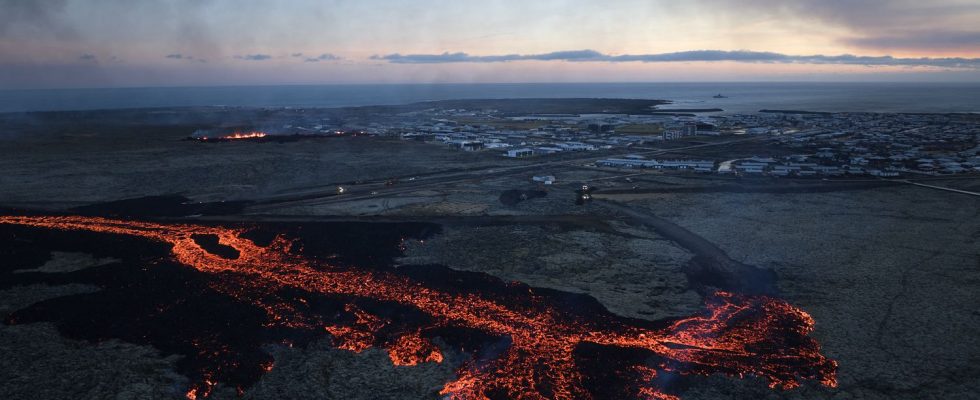Workers have taken turns since January 2 to erect a protection several meters high north of the port city of Grindavik. This line undoubtedly prevented much greater damage.
Bulldozers to counter lava flows. While a volcanic eruption still threatens the small port of Grindavik, in the southwest of Iceland, Monday 15 January, the future of the small coastal town rests partly on a dam several meters high and two kilometers long, erected urgently in the preceding days. “We worked day and night to install these dikes before” a flow of lava, explains to franceinfo Ari Gudmundsson, engineer for the company Verkis, in charge of this express work.
In this region of Iceland, no volcanic activity had been observed for eight centuries, but the soil suddenly started working again. “This is already the fifth eruption in the area in three years”observes Jacques-Marie Bardintzeff, volcanologist at Paris-Saclay University and author of Volcanologist (ed. L’Harmattan). Fortunately, Icelandic specialists had been anticipating the worst-case scenario for several weeks, even before a first eruption that occurred on the 18th. December. The project was launched at the beginning of the year. The construction of these barriers can be decisive “on the outskirts of a village, where every meter gained can count towards saving dwellings”, recalls the French expert. Especially since the threat is considerable : “The temperature can reach 1 000 or 1 100 degrees and not much resists.”

To erect these dikes, two methods are possible. “The first option is to divert the lava flows, for example by destroying the edges and sides of the natural flows, in order to divert them”explains Patrick Allard, volcanologist at the Institute of Globe Physics in Paris, citing a first experiment in Hawaii then in Italy, around Etna, in the early 1980s and 1990s. “But dams designed to contain the lava, or at least prevent it from advancing”the second option, “are a specialty of Iceland, which has the best experience in this areacontinues the volcanologist. On Sunday, they managed to preserve a good part of northwest Grindavik.”
Experiences in Hawaii and on Etna
Foreign experiences inspired the island’s engineers, recognizes engineer Ari Gudmundsson. “We had seen photographs and read articles about it”he explains, which triggered a first full-scale test in 2021, in the Geldingadalir valley, east of Grindavik. “They had already made barriers, hastily, to try to contain the lava flows, so that they would accumulate in uninhabited hollowsadds Patrick Allard. With some success, already.”
Last November, seismographs detected thousands of earthquakes, and then cracks began to run through the streets of Grindavik. As a matter of urgency, the Icelandic Parliament adopted a bill to introduce a new temporary property tax – 0.0008% on housing for three years – to finance the construction of these barriers. The Verkis company immediately began building a first structure, five kilometers long, in order to secure the Svartsengi geothermal power plant, an essential infrastructure for the peninsula.
Then from January 2, after taking note of the latest risk modeling, including topographical data, the teams focused on another line, above the town of Grindavik. Before carrying out a project, Ari Gudmundsson’s teams use computer models to anticipate and locate possible lava flows.

“We had done some calculations and one of these cracks was very close to the cityremembers Ari Gudmundsson. It was the worst-case scenario, and it happened.” At the start of the eruption, fortunately, two kilometers had already been built, out of the seven planned in total. “We were just finishing the first phaseexplains the engineer, and we had not yet decided what to do next with the government and Civil Protection.”, even if the final objective is to surround the city. Given a few days, the consequences could therefore have been much more significant.
A hole filled urgently on Sunday
On the outskirts of Grindavik, two fissures are spewing lava, according to the Icelandic Meteorological Office. The first, the most important, is located 400 meters just north of the town. The second, shorter, appeared on the edge of the first homes. On January 10, a man fell into another, older fissure that runs through the city. His body has still not been found.

Construction work progressed quickly. Verkis was able to use materials already present on site. Half of the rubble came from the site, and the other half was transported by heavy goods vehicles from the neighboring mine, before being deposited using backhoe loaders. During the eruption, there was still an opening in the barrier, where the main road passes. Sunday morning, “bulldozers and excavators went to fill this hole. We succeeded, not without difficultyexplains Ari Gudmundsson. There was a bit of lava spilling, but the barrier still held.”
“Some hot water pipes and electrical cables were damaged, but most of them were saved. These barriers, without a doubt, helped protect many homes.”
Ari Gudmundsson, engineer at Verkisat franceinfo
Three houses were still swallowed by flames on Sunday – the images went around the world. “But there was nothing they could have done.”comments Patrick Allard, because the crack concerned, more modest than the previous one, has dug to the south of the dikes.
The spokesperson for Icelandic Civil Protection, Hjördis Gudmunsdóttir, also gave rather reassuring information, judging that the flow of lava was less significant in this new fissure. The city still had 4 000 residents during the precautionary evacuation, ordered in November. But only a few dozen of them chose to return home, after the green light was given on the 23rd. December. The population is now observing the evolution of the situation, because the eruption is still ongoing.
“The lava does not pass the barrier and coolsassures Ari Gudmundsson. But we will closely observe developments in the coming hours.” Patrick Allard, for his part, is impressed by the efficiency of his Icelandic colleagues and by the local engineers. “The backhoe loaders continued to erect barriers at night, closer to Grindavik, while the flows were very closepoints out the volcanologist. They are pragmatic and work really well.”
